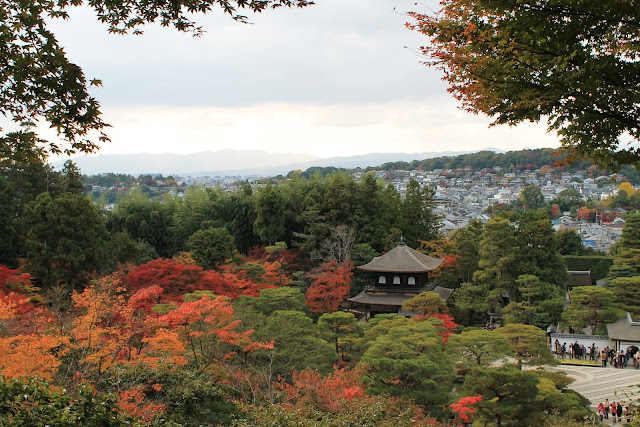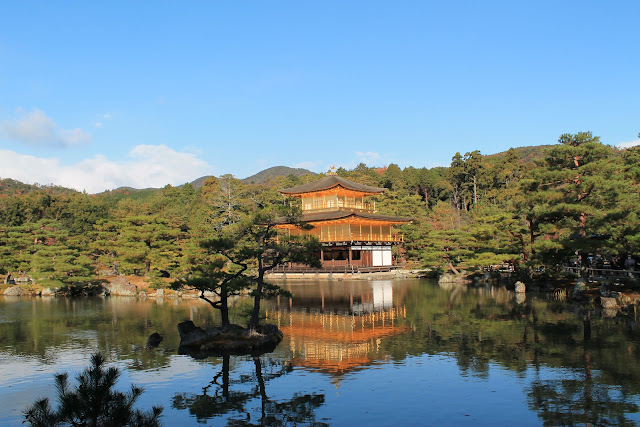While I didn't get there until over half of the semester had gone by, in the past month, I have been to Kyoto many times. One of the virtues of being situated in Osaka is the easy access to so many surrounding areas of historic and cultural interest, like Kyoto, which takes about 45 minutes for me to get to by train.
Kyoto, as the previous capital of Japan, has probably the highest density of places of interest. With 17 Unesco World Heritage sights to boast, there was no way to see it all. But I'll give you a highlight of the main sights I've seen. It certainly makes me thankful that, however morbid, the U.S. government ruled out Kyoto as a possibility for the dropping of atomic bombs during WWII specifically because of its historical and cultural significance. I'm happy to have been able to see it as the widely traditional city it is.
First, when Amber's great aunt Barb came to visit from Minnesota, we went on a little adventure to Nijo Castle. This is the home to the Nightingale Floors, which are floors that were designed to make noises when walked upon. They were intended to ward off ninja assassins, because the chirping floors were impossible to cross without making noise. Nijo castle was constructed during the Tokugawa shogunate, so there was a lot of historical reason for the shogun to be concerned about assassination attempts.
Unfortunately, we weren't permitted to take photographs inside the castle itself, but the above are pictures of the beautiful grounds.
The next time I went to Kyoto was for a Koyou night-viewing event. Koyou means the changing autumn leaves, and throughout Japanese history, the ritual viewing of the changing autumn leaves has been of the utmost importance in the yearly schedule. These kimono-clad women were perhaps also returning from a viewing, stepping back into modern culture.
In front of the temple stood several 800-year old Camphor trees. They were magical in the night air and I spent several minutes with friends re-enacting the "My Neighbor Totoro" raising of the Camphor tree.
We went on a beautiful clear night with a group from our school. There are Koyou night viewings throughout the city, but we went to the one at Shorenin temple. It was really stunning, and the photos don't do it justice.
One nice thing about Kyoto is that it is more mountainous than Osaka, so you can get amazing views of the city by just getting to the top of small hills.
Case in point: Kiyomizu-dera temple, our next stop on this flash sight-seeing tour. Kiyomizu-dera, a huge Buddhist temple site, was built to accommodate large numbers of pilgrims, so it was made on several different levels above the earth, the height of which is this amazing veranda.
The Japanese idiomatic equivalent of "to take the plunge" is "to jump off Kiyomizudera." And this expression has historical significance, of course. According to wikipedia, two hundred and thirty four individuals took the plunge during the Edo period, and 85% of them survived! That's impressive, considering it's a 13 meter drop.
The same day, we walked from Kiyomizu-dera to Ginkaku-ji, on opposite sides of the city. On the way, we had lunch in Gion (the famous Geisha district, though we didn't see any), and happened to walk through Heian Jingu by chance, a site we probably wouldn't have otherwise gotten to see. This is the giant Torii gate that leads to the temple, right in the middle of the hustle and bustle of Kyoto.
This day was not just one of the best experiences in terms of sightseeing, as we got to do a lot for such a short period of time. But it was also a day of magic. On the way to Ginkaku-ji (below), we walked along the Philosopher's Walk, a canal famous as the meditation spot for Japanese philosophers.
Ginkaku-ji is sorely under-rated in guidebooks and by word of mouth. Perhaps we went when the leaves were just right, but the grounds were amazing. Ginkaku-ji and Kinkaku-ji were both famous properties of the once rich and famous, two brothers' mansions in Kyoto now converted into temples for the tourists.
Kinkaku-ji was covered in gold leaf (see down below), so the brother intended to cover Ginkaku-ji in silver leaf, but died before he could do it. That's sad, true, but the grounds themselves make for a much more interesting experience than at Kinkaku-ji.
I enjoyed both thoroughly, don't get me wrong, but it's not just that I'm a fan of the underdog. No matter what you may hear or read, believe me when I say that if you only have time for one while you're in Japan, should you ever find yourself here, take a stroll through Ginkaku-ji rather than step into the postcard of Kinkaku-ji.
Because for how absolutely fabulous Kinkaku-ji was, you can get the amazement from looking at a postcard, or at my photos, whereas my photos don't do the same justice to the awe I experienced while walking around Ginkaku-ji.
Now it's time for a magical story of a magical day in Kyoto. Once upon a time, there were three American girls who biked to school together every morning. These three girls would pass the same group of jolly old men, taking their daily walk together. The girls would say good morning, and the old men would give them high fives as the girls passed by on bike, or offer jokingly to push them up the one hill they had to climb to go on their merry ways to school.
One day, far away from America, and far away from their home in Japan, as the girls were walking along the Philosopher's Path, they met the old men! The same old men that they saw every day more than an hour away!! The girls looked at them, and wondered if it was really them, and the men looked at the American girls, and wondered whether it was really them, until finally the whole lot of them burst into laughter in jolly merriment and exchanged stories right there on the edge of that tree-lined canal where great thinkers once thought.
Indeed, we did see them that day, and that super fun experience of running into them made me feel so at home. This world is so small, and even in a nation jam-packed with millions of people, you can still see your neighborhood retirees on their morning walk, wherever you go.
That made me also feel like everything happens for a reason. I was meant to be there with my roommates, the people I go to school with every day, to see those men, the men we see every day. So I wasn't as upset as one might assume when it came to my attention that my visa for France would not come through. I have had to postpone my time in France until a later date yet to be determined. However, when one thing goes wrong, usually something good also comes your way. And came it did. My loving grandmother (if you remember when I wrote about mah-jong, she's the one we play with) offered to fly my cousin, Christopher Paul, to come visit me in Japan. And together, we will travel the globe until I return to the United States next month. He gets here in two days, so there's more to come on those adventures! Hakuna Matata, while not exactly a Japanese phrase, is a philosophy worthy of stumbling upon on my philosopher's walk.


















No comments:
Post a Comment